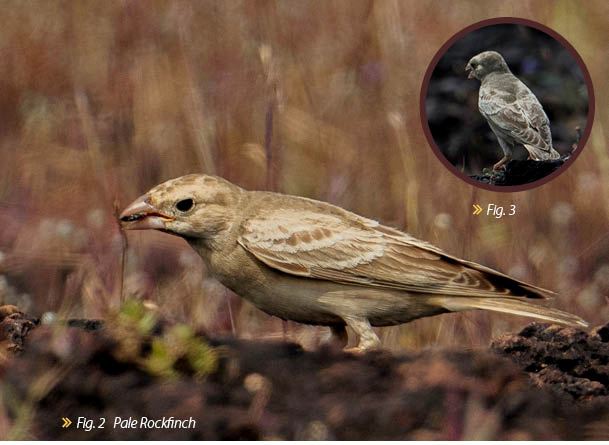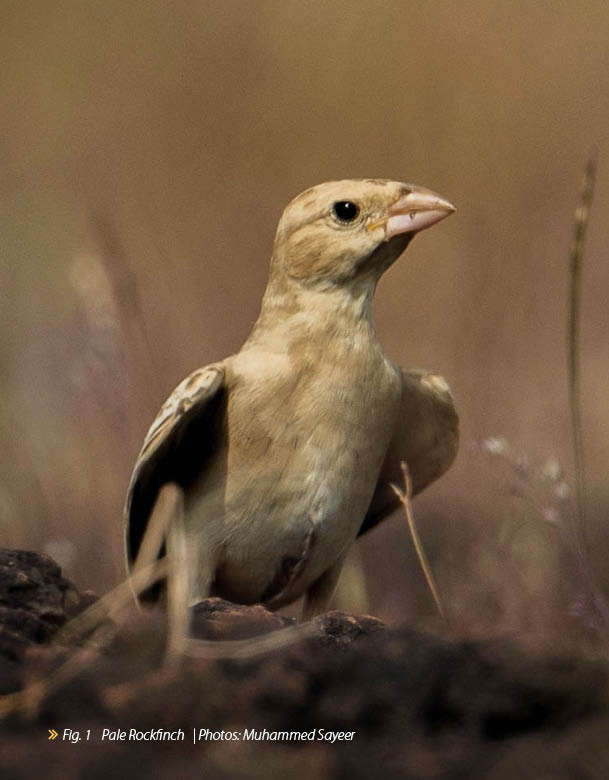On 6 October 2019 we were on a trip to Madayippara, a laterite hillock situated in Kannur district, Kerala, famous for its biodiversity and a hotspot for birders, to sight two species in our wish list. While birding, among common birds like pipits and larks we noticed a small pale brown sparrow-like bird foraging on the ground that stood apart from the other birds on account of its pale colour against the dark laterite. We observed the bird and photographed it from various angles. But, we could not hear any call. The bird was not familiar to us and we could not identify it even after referring to a field guide. The bird had extremely plain, unstreaked pale sandy plumage, a weak pale supercilium and vaguely paler sub-moustachial stripe (Fig. 1). Underpart was whitish with sandy breast; the wings were long with two whitish wing-bars (Fig. 2) and the dark brown tail showed white terminal tail-spots on outer feathers (Fig. 3).

The pictures taken were posted in Kerala Bird Monitoring Whatsapp group for identification and Ramit Singal as well as Praveen J identified the bird as Pale Rock Sparrow/Pale Rockfinch Carpospiza brachydactyla. India is not its usual migrating land and thus it considered as a vagrant to the Indian subcontinent. Only four previous sightings were found in the eBird database. The first report of Pale Rockfinch was in February 2012 from Tal Chhapar, Rajasthan (Poonia, Sharma & Sangha , 2012) and then in October 2012 from Manipal, Karnataka (Singal, 2013) and also from the Raan of Kutch, Gujarat (Tiwary, 2012).
Pale Rockfinch is found in the Middle East and Central Asia. Its range extends from eastern Turkey to Afghanistan, and south into the Arabian Peninsula and northern Africa as far as Ethiopia. It breeds from Middle East to Iranian Baluchistan and winters to North East Africa (Rasmussen & Anderton, 2012). Its natural habitats are barren, rocky desert and semi-desert slopes (Summers-Smith & Denis, 2009). It is the only member of the genus Carpospiza. Some authorities include it in the genus Petronia. Others have placed it in the finch family due to some similarities in behaviour and form, but the anatomy of its tongue exhibits characteristic sparrow features (Bock, 2004).
The authors thank Ramit Singal and Praveen J for identifying the bird. We express our gratitude to Abhinand Chandran for helping to redact this note.
References
- BirdLife International. (2012). “Petronia brachydactyla”. IUCN Red List of Threatened Species. Version 2013.2. International Union for Conservation of Nature. Retrieved 26 November 2013.
- Bock, W. (2004). Affinities of Carpospiza brachydactyla (Passeriformes: Passeridae). Journal of Ornithology, 145 (3): 223-226. DoI:10.1007/s10336-004-0034-9.
- Poonia, S. S., Sharma, M., & Sangha, H. S. (2012). Pale Rock Sparrow Carpospiza brachydactyla in Gopalpura Hills, Tal Chhapar (Churu district, Rajasthan): a new species for the Indian Subcontinent. Indian BIRDS, 7(6): 159-160.
- Rasmussen, P. C., & Anderton, J. C. (2012). Birds of South Asia: the Ripley guide: 2nd ed. Washington, D.C. and Barcelona: Smithsonian Institution and Lynx Edicions. 2 vols. Pp. 1-577.
- Singal, R. (2013). Pale Rock Sparrow Carpospiza brachydactyla from Manipal, Karnataka, India. Indian BIRDS, 8(3): 78.
- Summers-Smith, J. Denis. (2009). Family Passeridae (Old World Sparrows). In del Hoyo, Josep; Elliott, Andrew; Christie, David (eds.). Handbook of the Birds of the World. Volume 14: Bush-shrikes to Old World Sparrows. Barcelona: Lynx Edicions. ISBN 978-84-96553-50-7.
- Tiwari, J. K. (2012). Pale Rock Sparrow Carpospiza brachydactyla : a new species for India. BirdingASIA, 17: 117–118.
